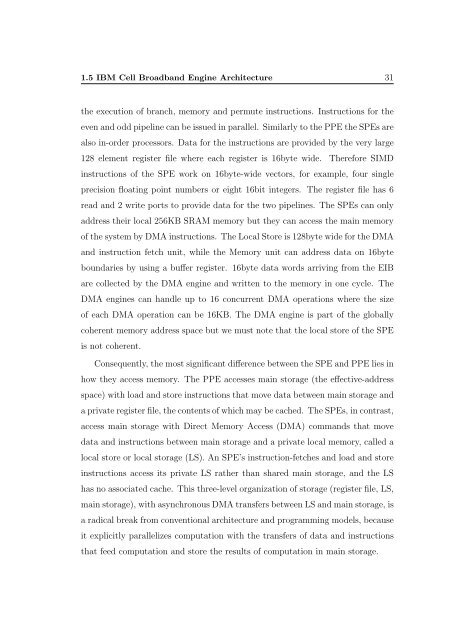PPKE ITK PhD and MPhil Thesis Classes
PPKE ITK PhD and MPhil Thesis Classes
PPKE ITK PhD and MPhil Thesis Classes
Create successful ePaper yourself
Turn your PDF publications into a flip-book with our unique Google optimized e-Paper software.
1.5 IBM Cell Broadb<strong>and</strong> Engine Architecture 31<br />
the execution of branch, memory <strong>and</strong> permute instructions. Instructions for the<br />
even <strong>and</strong> odd pipeline can be issued in parallel. Similarly to the PPE the SPEs are<br />
also in-order processors. Data for the instructions are provided by the very large<br />
128 element register file where each register is 16byte wide. Therefore SIMD<br />
instructions of the SPE work on 16byte-wide vectors, for example, four single<br />
precision floating point numbers or eight 16bit integers. The register file has 6<br />
read <strong>and</strong> 2 write ports to provide data for the two pipelines. The SPEs can only<br />
address their local 256KB SRAM memory but they can access the main memory<br />
of the system by DMA instructions. The Local Store is 128byte wide for the DMA<br />
<strong>and</strong> instruction fetch unit, while the Memory unit can address data on 16byte<br />
boundaries by using a buffer register. 16byte data words arriving from the EIB<br />
are collected by the DMA engine <strong>and</strong> written to the memory in one cycle. The<br />
DMA engines can h<strong>and</strong>le up to 16 concurrent DMA operations where the size<br />
of each DMA operation can be 16KB. The DMA engine is part of the globally<br />
coherent memory address space but we must note that the local store of the SPE<br />
is not coherent.<br />
Consequently, the most significant difference between the SPE <strong>and</strong> PPE lies in<br />
how they access memory. The PPE accesses main storage (the effective-address<br />
space) with load <strong>and</strong> store instructions that move data between main storage <strong>and</strong><br />
a private register file, the contents of which may be cached. The SPEs, in contrast,<br />
access main storage with Direct Memory Access (DMA) comm<strong>and</strong>s that move<br />
data <strong>and</strong> instructions between main storage <strong>and</strong> a private local memory, called a<br />
local store or local storage (LS). An SPE’s instruction-fetches <strong>and</strong> load <strong>and</strong> store<br />
instructions access its private LS rather than shared main storage, <strong>and</strong> the LS<br />
has no associated cache. This three-level organization of storage (register file, LS,<br />
main storage), with asynchronous DMA transfers between LS <strong>and</strong> main storage, is<br />
a radical break from conventional architecture <strong>and</strong> programming models, because<br />
it explicitly parallelizes computation with the transfers of data <strong>and</strong> instructions<br />
that feed computation <strong>and</strong> store the results of computation in main storage.






![optika tervezés [Kompatibilitási mód] - Ez itt...](https://img.yumpu.com/45881475/1/190x146/optika-tervezacs-kompatibilitasi-mad-ez-itt.jpg?quality=85)









